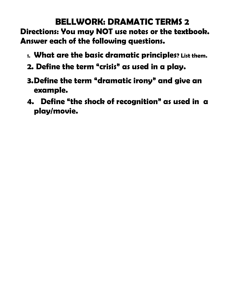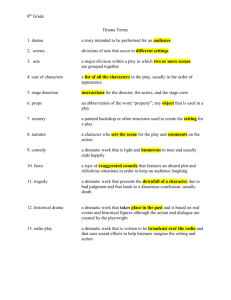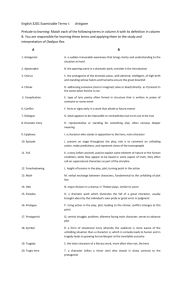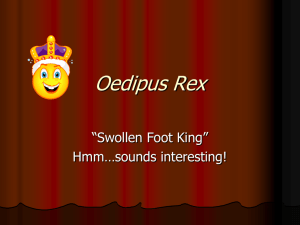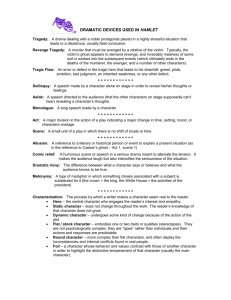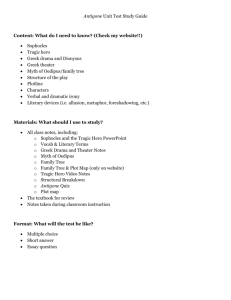4-18 drama intro
advertisement
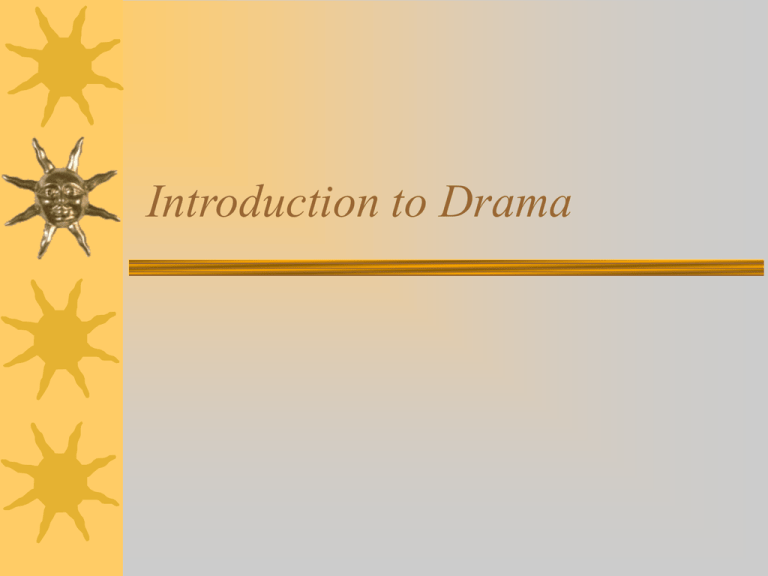
Introduction to Drama Definition Unlike short stories or novels, plays are written for the express purpose of performance. Definition Actors play roles and present the storyline through dialogue, action, and gestures. Definitions For the most part, plays have no narrators. The audience must glean critical information from the action on stage. Dealing with Details Unlike novels or short stories, plays have special features. – Plays are divided into acts and scenes. – Scripts feature lists of characters and stage directions which require the reader to pause and visualize the set up. – Readers and actors must pay close attention to the dialogue in order to understand the characters and action. Two Basic “Flavors” Comedy Comedies are dramatic works which use humor to explore various themes and characters. Comedies usually end on a happy note. Tragedy Tragedies treat serious subjects and often focus on the tragic hero’s character. Tragedies usually end with death. Key Terms Modern Realism – Modern Realistic drama deals frankly with contemporary life and social issues— particularly minority issues. Instead of focusing on the lives of kings or great heroes, these dramas present a look at ordinary people and everyday problems. Key Dramatic Terms Dialogue – conversation between two or more characters Monologue – an extended speech by one character Soliloquy – an extended speech by one character, alone on stage. Soliloquies are used to express the private thoughts of one character. Aside – a character’s direct address to the audience, which is not heard by the other characters Monologues, soliloquies, and asides are dramatic techniques that provide direct insight into motives, attitudes, and overall tone. These techniques function like a fictional narrator. Key Dramatic Terms Stage Directions – instructions printed in italics and/or in parentheses and used to describe sets, lighting, sound effects, and the appearance, personalities, and movements of characters performing a particular play (not meant to be spoken) Conflict – struggle between opposing forces in a play or story Internal conflict exists within the mind of a character who is torn between different courses of action. • Man vs. Himself External conflicts exist when a character struggles against some outside force. • • • • Man vs. Man Man vs. Society Man vs. Nature Man vs. God or Fate Key Dramatic Terms Characterization – creation of characters for a play or story – Direct – telling the audience/reader exactly what you want them to know about the characters, only used in stage directions or by a narrator – Indirect – character is demonstrated through his/her actions and words and the actions and words of the other characters Key Dramatic Characters Protagonist – central character or “hero” of the drama Antagonist – person or thing working against the protagonist Foil – character whose behavior and values contrast with another character’s (usually the protagonist’s) in order to highlight the distinctive traits of that character Key Dramatic Characters Round – multi-faceted personalities, display inconsistencies and internal conflicts found in most real people Flat – embody one or two qualities, ideas, or traits that can be readily accessible to audiences, usually stereotypes Dynamic – those who undergo some type of internal change (in beliefs, point of view, etc.) before the resolution of the plot Static – one that doesn’t change throughout the work, knowledge of character does not grow Key Dramatic Character Tragic Hero – has the potential for greatness but is doomed to fail; trapped in a situation that cannot be won resulting from a tragic flaw within character, this causes fall from greatness – Classical or Shakespearean tragic heroes are men or women of nobility and greatness caught up in worldly events of vast significance (wars, kingships, etc.) Key Dramatic Character Modern Tragic Hero – as classified by Arthur Miller, playwright of The Crucible and Death of a Salesman “I believe that the common man is as apt a subject for tragedy in its higher sense as kings were.” “Tragedy, then, is the consequence of a man’s total compulsion to evaluate himself justly.” “The [tragic] flaw… is really nothing… but his inherent unwillingness to remain passive in the face of what he conceives to be a challenge to his dignity.” Key Dramatic Character Modern Tragic Hero examples – – – – – – – John Proctor from The Crucible Sirius Black from Harry Potter Boromir from The Lord of the Rings Anakin Skywalker from the Star Wars’ prequels Willie Loman from Death of a Salesman Elphaba from Wicked Sweeney Todd Plot – storyline & sequence of events Exposition – introduces the characters, setting and basic situation Rising action – presents the central conflict, complications, suspense and crisis Climax – the point of greatest tension, turning point Falling action – subsiding intensity, resolution of minor conflicts Denouement/Resolution – the resolution which ties up loose ends and concludes the action Plot Structure Reading Drama Pay particular attention to the overall plot. – What are the major conflicts or issues? – When does the climax occur? – What force or forces seem to be at work in the play, moving the action along? Pay close attention to characters. – Who are the central Photo credit: Cat on a Hot Tin Roof by Tennessee Williams. Cornell Schwartz Center for the Performing Arts. characters? – What do you know about their personalities? How do you know this information? – What are the characters’ strengths and weaknesses?
